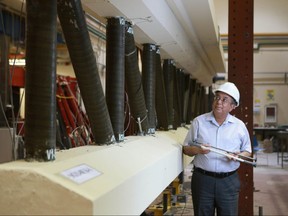Building a better bridge: U of C engineer has designs on stiffer spans

Article content
Perhaps it’s a hurdle that links back to the old phrase that implies the gullibility of a potential mark.
The idiom “I’ve got a bridge to sell you” harkens back to a duo of early 20th-century con-men, George C. Parker and William McCloundy, who infamously conned unwitting tourists to New York into “buying” the Brooklyn Bridge.
For Mamdouh El-Badry, a professor at the University of Calgary’s Schulich School of Engineering, building a better bridge has been a labour of love for nearly two decades — but it’s also been an enduring source of frustration as he tries to convince governments and engineering firms about a technology that could forever alter how spans are designed and built.
“It’s been difficult — sometimes people aren’t open-minded,” said the native of Egypt who graduated from the U of C in the late 1980s.
“When I’ve talked to people on the engineering side, they tell me, ‘I don’t need research, I need something tomorrow.’ ”
But the research, along nearly three dozen prototype bridge trusses at the university, has the potential to be revolutionary.
Where traditional bridges, both high- and low-volume spans, use precast or cast-in-place concrete girders buttressed by steel, El-Badry has been researching the use of glass fibre reinforced polymers, which could make bridges cheaper, lighter and vastly more resilient than the current standard.
El-Badry’s bridge trusses encase concrete in glass fibre tubes, creating stronger, lighter and more durable spans, which the professor said reduces the weight of a bridge anywhere from 23 per cent to 37 per cent, with a proportionate reduction in overall cost. And while a typical concrete bridge built with existing technology is generally thought to have a 50-year lifespan, El-Badry maintains his technology can double or even triple that lifespan, primarily due to the corrosion-resistant material.
It also allows engineers, thanks to the reduced weight, to build longer spans with fewer support piers, reducing their potential effect on the environment and other infrastructure.
The benefits to governments and others in the business of building bridges are pretty clear to the long-toiling span savant.
“It could save billions,” said an unflinching El-Badry.
History is filled with examples of bridges failing for a number of reasons, ranging from poor engineering to environmental factors, including Calgary’s Bonnybrook train bridge in 2013, which buckled under rushing flood waters, stranding several rail cars that hung precariously over the Bow River before their removal.
Because El-Badry’s design uses a Pratt-style truss, somewhat like a lattice, to hold bridge decks — also reinforced with the same glass fibre — as opposed to solid concrete beams, water more easily flows by, something the professor claims will make them more resilient in shrugging off torrents of rushing water.
Following the 2005 floods in southern Alberta, El-Badry nearly had the real-world bridge he had been looking for, contacted by the province and a rural municipality about potentially replacing flooded out spans with his technology. However, those fell through, so the only place to find the next-level tech is in a two-storey lab in the bowels of the Schulich School of Engineering, where they undergo stress and environmental testing, pushing them to their limits.
He’s also had some tire-kicking from the Ontario government and engineering giant SNC-Lavalin, but his test bridge remains elusive.
Coun. Shane Keating, who chairs the city’s transportation committee, said he’s intrigued by the idea, noting sometimes the city struggles to think outside the box when it comes to major infrastructure builds.
Keating said he would like to see the city use the technology in a smaller bridge project, potentially a pedestrian span, to see how it works and monitor it to see if it can be expanded to other future projects.
“The city has a bit of a mentality where they don’t want to be the first on wanting to try something because they want somebody else to try and test it,” he said.
“I’m saying, let’s go out and pilot it and see how it does.”
Bridge costs can vary widely depending on the size and complexity.
The budget for the replacement of the old steel 12th Street S.E. bridge connecting St. George’s Island to Inglewood is approximately $26 million. By comparison, the 61st Avenue S.W. pedestrian bridge at Chinook Centre carries a $13-million price tag.
For El-Badry, he’s just thankful to have a showcase for his technology that may act as a springboard for more future projects.
“What I’m hoping for is to get some support to build one here in Calgary,” he said.
“It’s been kind of disappointing, but I’m still hoping I’ll see it happen.”
On Twitter: @ShawnLogan403






Postmedia is committed to maintaining a lively but civil forum for discussion. Please keep comments relevant and respectful. Comments may take up to an hour to appear on the site. You will receive an email if there is a reply to your comment, an update to a thread you follow or if a user you follow comments. Visit our Community Guidelines for more information.